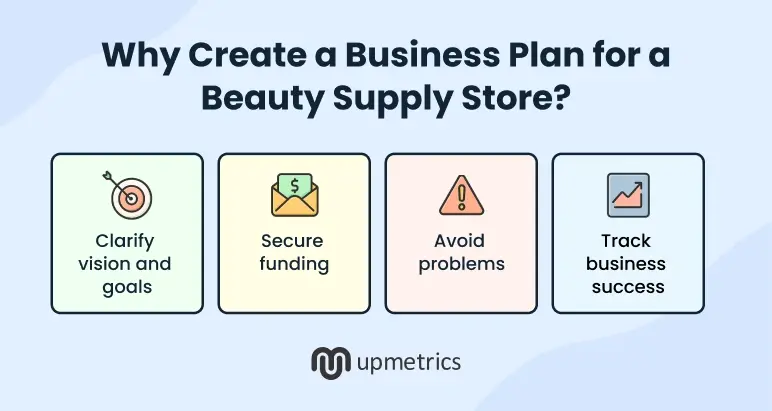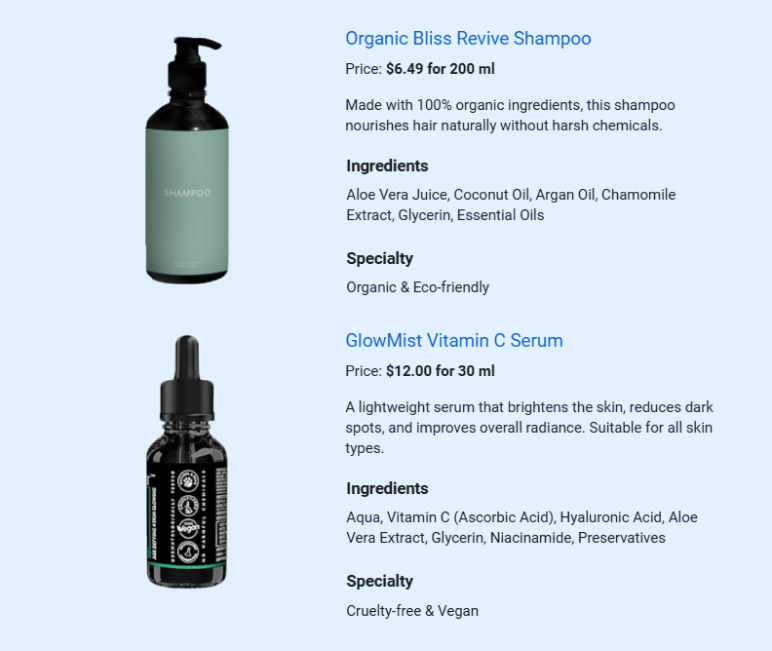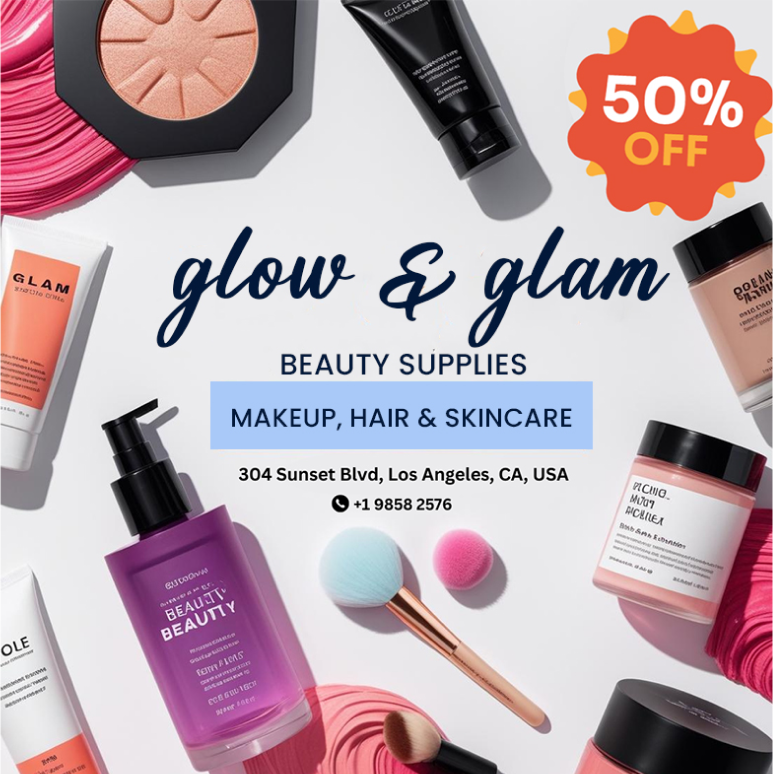New beauty store owners often invest heavily in inventory, only to realize they don’t have a strategy to turn browsers into buyers. Competing in a crowded market without guidance can make launching feel impossible.
That’s why we created this template. It walks you step by step through marketing, finances, operations, and inventory—so you can launch your store confidently.
Download this free beauty supply store business plan template and get closer to opening a successful store.
Keep reading for tips on how to use the template and create a plan with ease.
Why create a business plan for a beauty supply store?
A business plan serves as a strategic blueprint for your beauty supply store startup, especially when you aim to thrive in the competitive beauty industry.
Here are some key reasons why you need a business plan to start and grow a new beauty supply store:

1. Clarify vision and goals
A business plan lets you clearly explain your store’s vision and goals. It shows what steps you need to take to reach them and guides your daily decisions.
2. Secure funding
Many new stores need extra money to start. A business plan helps you get loans or investors because it shows a clear strategy to make your store profitable.
3. Identify risks earlier
Every business faces challenges. A business plan helps you spot potential risks and plan how to handle them, saving time, money, and stress.
4. Track business success
A business plan helps you set goals and measure success. You can track your growth, update your strategies, and stay aware of trends in the beauty industry.
What to include in your beauty supply store business plan?
When writing a business plan for your beauty supply store, include the most important parts that explain your goals, how you’ll run the store, and how you’ll make money.
Here are the main sections you should include:
1. Executive Summary
Every successful beauty supply store starts with a clear vision—and your executive summary is where that vision comes to life. It’s the first section of your business plan, but often the last one you’ll write, once all the details are ready.
This part gives a quick snapshot of your whole plan, so readers quickly get your beauty supply store idea. Think of it as the “trailer” for your business plan—short, clear, and engaging, usually one to two pages long.
In this section, you’ll introduce your store and highlight the key points:
- Business name and location
- Types of beauty products you’ll sell
- Mission and vision statement
- Target customers or market needs
- Unique selling points
- Financial outlook
If someone only reads this section, they should still understand what your store does, the chance you’re focusing on, and how you plan to succeed. Keep the tone positive and the language simple—the goal is to give a clear, quick overview and make a strong first impression.
2. Business Description
The business description gives a simple background of your beauty supply store. It explains what your store does, why it matters, and what you want to achieve.
Start by describing what kind of beauty store you run and its name. You might specialize in:
- Hair care products
- Skincare and cosmetics
- Nail care and beauty tools
- A mix of all beauty products
Also, say where your store is and why you picked that place. Mention your business legal structure—sole proprietorship, LLC, partnership, or other.
If your store is already running, briefly share its history, like when it was started and how it has grown.
Next, write your mission and vision. The mission is what your store wants to do—for example: “To make quality beauty products easy to find and affordable.” The vision is your long-term goal, like becoming the top beauty supply store in your area.
Then, say what problem you’re solving. For example, helping customers find products for all hair types and skin tones, or offering brands that are hard to find.
Lastly, mention your short-term and long-term goals, like getting your first customers, adding more products, or opening more stores.
Overall, this section should give a clear idea of your store, its purpose, and its future plans. Keep it simple, clear, and to the point.
3. Product & Service Offerings
This section of a beauty supply store plan describes the products and services you’ll offer to customers. It shows how you’ll make money and provide value to your customers.
Start by listing the types of products you’ll sell:
| Product Category | Examples |
|---|---|
| Hair Care | Shampoos, conditioners, oils |
| Skincare | Creams, masks, lotions, serums |
| Makeup | Lipsticks, eyeshadows, foundations |
| Nail Care | Polishes, tools, kits |
| Beauty Tools | Brushes, combs, hair dryers, etc. |
Next, talk about your product quality. If you sell natural, organic, cruelty-free, or high-quality branded products, mention that. For example:

Adding this helps customers trust your products.
If your products come in attractive, gift-ready, or eco-friendly packaging, include that too. People like products that look nice.
Then, mention the services you’ll provide, for example:
- Beauty consultations to help customers choose the right products
- Gift wrapping or custom gift sets
- Home delivery or online order support
Finally, keep your prices simple and clear. Say if items are sold individually, in sets, or as bundles. You can also offer subscription boxes or special gift packages.
In short, this section shows what your store sells, what makes your products special, and why customers will want to buy from you.
4. Market Analysis
Before starting your beauty supply store, it’s important to understand the beauty industry, including who your customers are, what they need, and what competitors are doing. The market analysis shows that you’ve done your research and are ready to meet real customer needs.
Industry overview
Start by looking at how the beauty supply industry is performing. Is this a growing field? If possible, include a statistic to show the opportunity. For example:
“The global beauty supplements market will grow from about $3.96 billion in 2025 to over $5.76 billion by 2030.”
Target market
Think about the types of customers your store will serve and what they want:
- Teens & young adults: Trendy makeup, skincare, hair accessories
- Women & men: Hair care, skin care, grooming products
- Salons & stylists: Professional products in bulk
Consider their age, where they shop (online or local), and if they want special options like cruelty-free or organic products.
Market trends or gaps
Look at what’s popular and what’s missing in the market. Some trends include:
- People want products for all hair types and skin tones.
- Natural, organic, or cruelty-free products are in demand.
- Customers like loyalty programs or special offers.
- Online shopping with home delivery is growing.
Competitive analysis
Check who else is selling beauty products in your area or online. Start with direct competitors, like other beauty supply stores, and then look at indirect ones, like supermarkets or online stores.
Note what products they sell, their pricing, and the type of customers they target. You can also do a simple SWOT analysis to see your strengths, weaknesses, opportunities, and risks.
Licensing and rules
To run your beauty store legally, you might need:
- A business license
- Sales tax registration
- Any permits required for cosmetics or imported products
This shows you understand the rules and are ready to run your store safely and professionally.
The market analysis section proves that your beauty supply store is based on research, real customer needs, and industry trends. You’re not just opening a store—you’re offering products and services that customers actually want.
5. Marketing Strategies
Having good beauty products is important, but people need to know about your store. A simple marketing plan helps reach customers, make sales, and keep them coming back.
In this section, outline the methods and channels you’ll use to connect with your target audience and encourage repeat business. For example, you could use:
Social media: Share posts about products, beauty tips, tutorials, and special offers on Instagram, Facebook, or TikTok.
Local marketing & referrals: Work with salons or makeup artists. Take part in local events and fairs, and hand out flyers near salons, offices, or busy streets. Here’s a sample flyer you can use as inspiration to create your own:

Paid ads: Run small online ads on Facebook or Google to reach more people.
Website: Show your products, prices, and how to order online on your website. Include customer reviews, too.
Helpful content: Share short blogs, videos, or emails with beauty tips and product advice.
After that, discuss your sales process:
- Help customers choose products and suggest bundles or gifts.
- Follow up with online buyers or loyalty members.
- Keep track of popular products to improve service.
If your store has a special feature, like “Free Samples” or “Products for All Hair Types,” mention it here.
Hence, drafting a well-thought-out marketing plan shows potential investors or lenders that you know how to reach the target audience, make shopping easy, and keep customers coming back to you.
6. Operations Plan
The operations plan section explains how your beauty supply store will operate every day. It shows that your store is organized and ready to serve customers well.
Here are some questions to answer when writing this section:
- Where will you run your store? Will it be a physical shop or online?
- How will customers reach you? Through your website or social media?
- Will you use any tools or apps to manage orders? How will you track payments and inventory?
- Who will supply your products? Will you work with delivery services or other partners?
- Are you running the store alone now? When will you hire staff, like assistants or online helpers?
- How will you keep customers happy? Will you deliver orders on time and ask for feedback?
In short, this section shows that your store is ready to operate smoothly and give customers a positive shopping experience.
7. Management Team
Team members are the heart of any business, and a beauty supply store is no different. The management team section introduces the people running your store and the experience they bring.
Start by telling about yourself. If you’re the owner, give a short introduction, sharing your background in retail, sales, customer service, or beauty products.
If you have other team members, like a store manager, sales assistants, online order staff, and a cashier, introduce them here. For each person, include:
- Their job titles
- What they do in the store
- Their experience and skills
If helpful, create a simple organizational chart to show who does what and how roles are connected.
Don’t forget to mention any advisors or mentors who support your business. Their guidance can help make your store stronger.
Overall, this section shows that your beauty supply store is run by a skilled and organized team, ready to give customers great service.
8. Financial Projections
Creating realistic financial projections shows the expected financial performance and requirements of your beauty supply store. The goal is to demonstrate that your business is financially viable and give readers insight into the economics of your store.
Start by listing your initial startup expenses. This might include:
- Business registration and license fees
- Lease or shop setup costs
- Interior setup (shelves, display units, counters)
- Initial inventory purchase
- Website setup
- Marketing materials
- Insurance
Now, explain how your business will make money. Your store earns primarily through selling beauty products, but you may also earn from:
- Special product bundles or gift sets
- Loyalty programs or membership fees
- Commissions from partnered brands
Provide a forecast of your sales for at least the first 3 years.
Then, list your expected costs.
Fixed costs: Rent, utilities, insurance, software subscriptions, loan payments
Variable costs: Inventory restock, packaging, marketing promotions, in-store events
Include basic financial statements for the next 3 years:
- Income statement
- Cash flow statement
- Balance sheet
From these, figure out your break-even point—how many products or monthly revenue you need to cover your costs.
Lastly, if you’re asking for funding, clearly state how much you need and how you’ll use it.
When writing this section, keep the language clear and avoid overly technical jargon. This section should show you understand your finances and can run a profitable beauty supply store.
Download a free beauty supply store business plan template
Ready to start drafting your beauty supply store business plan, but not sure where to begin? We’ve got you covered! Download our free beauty supply store business plan template PDF and get started right away.
This simple, ready-to-use template is designed for beauty store owners. It comes with real examples and easy tips to help you build a strong plan—whether you need it for getting a loan, finding partners, or running your store smoothly.
The Quickest Way to turn a Business Idea into a Business Plan
Fill-in-the-blanks and automatic financials make it easy.
Conclusion
Now that you know how to create a solid beauty supply store business plan, you’re ready to set clear goals, attract customers, and grow your business the right way.
Still feeling unsure or want to make the process faster? Upmetrics can help.
It offers smart features like an AI business plan generator, pitch deck maker, financial forecasting software, and market research tools—all designed to save you time and effort.
So why wait? Start planning your beauty supply store today and turn your idea into a thriving business!



